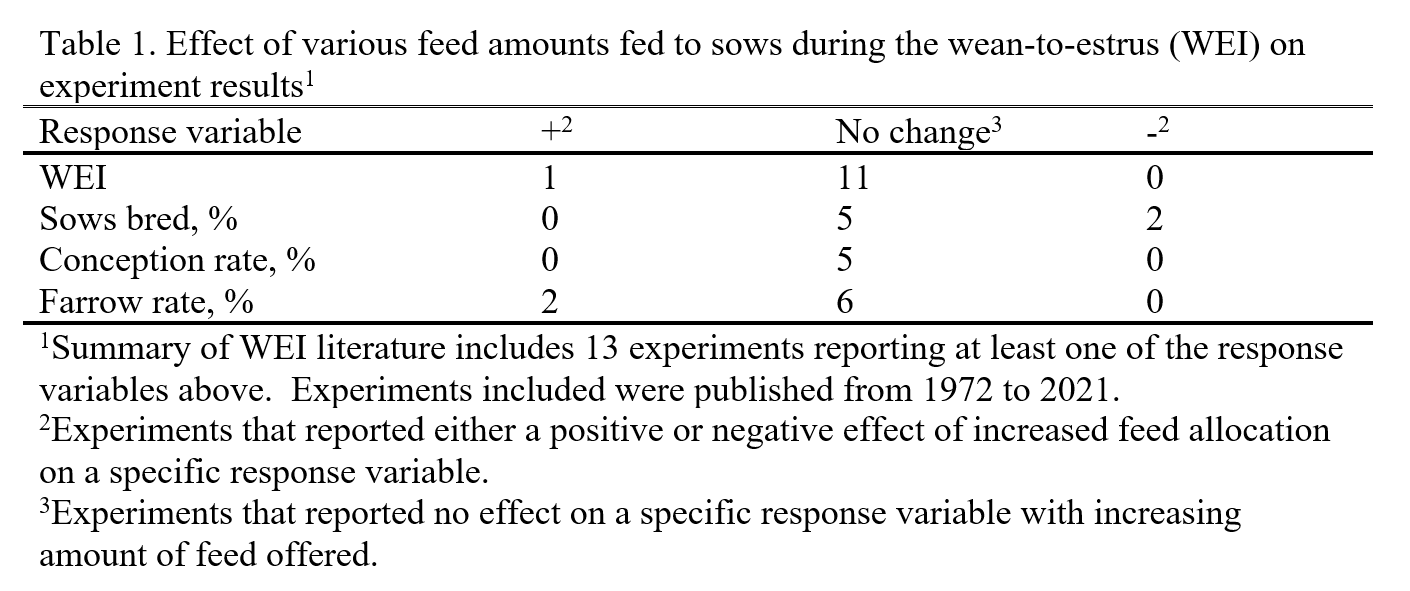By Kelsey L. Hammers, Lee J. Johnston, and Pedro E. Urriola, University of Minnesota
The wean-to-estrus interval (WEI) is defined as the number of days between weaning and the first day standing heat is observed. This is a critical timepoint to breed newly weaned sows to ensure herd productivity and maintain a high number of litters produced per sow per year. The average WEI on farms ranges from four to five days with most sows bred within seven days post-weaning.
Sows often lose body weight due to high nutrient demands in lactation that are met by mobilizing body stores when intake is limited. Severe weight loss during lactation can negatively affect subsequent rebreeding by delaying standing heat, inevitably increasing a sow’s non-productive days and possibly decreasing longevity and compromising follicular quality.
Many swine producers have full-fed sows right after weaning to recover body reserves lost in lactation. Full feeding has been a common practice because producers assumed it is required to ensure optimal subsequent reproductive performance. Full feeding leads to increased feed wastage and feed costs. Literature focusing on sow nutrition during the WEI has been scarce; however, several recent studies now suggest little to no economic benefit of full feeding sows in the immediate post-weaning period.
In the 1970’s and 1980’s, researchers hypothesized that increasing the amount of feed offered to sows postweaning would decrease days to rebreeding and increase subsequent litter size and fertility. For young, first parity sows, this hypothesis was supported by two studies. In one study, length of the WEI decreased and farrowing rates improved for sows fed 8.0 lbs. compared with sows fed the lowest feed level of 4.0 lbs./d (Table 1). Other researchers reported increased ovulation rate and litter size in first parity sows receiving 8.8 lbs/d compared with 3.3 pounds. Increasing the amount of feed offered up to 10 lbs./d postweaning provided no reproductive benefits for older, multiparous sows. From these early studies, full feeding may have provided some benefit to producers by shortening the WEI and improving reproductive performance of young sows and possibly for any sows in poor body condition resulting from significant weight loss in lactation.
Studies focused on feeding a highly prolific, modern sow during the WEI have been limited until recently. No differences in reproductive performance parameters or WEI were observed in four, large-scale experiments for sows fed a typical amount of feed ranging from 6.0 to 6.6 lbs./d compared to sows fed a much greater amount of feed ranging from 8.3-12.0 lbs./d regardless of body condition at weaning. While the majority of these studies suggest no benefit of extra feed during WEI, a group of researchers did observe an increase in farrowing rate from 88.3% to 93.3% for sows fed 8.3 lbs./d compared with sows fed 6.0 lbs./d. It is possible that sows require specific nutrients rather than “simply more feed.” Therefore, researchers have investigated the benefits of supplementing the postweaning diet with simple sugars such as glucose and dextrose to provide sows with a carbohydrate-rich diet that might promote follicular development and follicular quality induced by secretion of insulin and insulin growth factor. However, these interventions have also resulted in no differences in subsequent reproductive performance.

The current WEI lengths on commercial farms have reduced drastically in comparison to past decades. Therefore, there is much less time for additional feed to influence reproductive performance or body condition of weaned sows. Additionally, feed intake during this period can be limited by parity, weaning stress, the expression of estrus, and adequate body condition. Consequently, extra feed offered during the WEI increases feed wastage as most sows will not consume large amounts of feed.
In summary, full feeding sows postweaning in earlier decades may have been beneficial, especially for younger females to help replenish body nutrient stores. However, recent research suggests that full feeding sows supports minor or no improvements in reproductive performance and offers no economic benefit to producers. Expression of estrus rapidly after weaning and associated stresses of weaning may limit feed intake thus preventing high levels of nutrient intake. Thus, sows can be fed up to 6 lbs./d of a corn-soybean meal based WEI diet to ensure optimal subsequent reproductive performance.
Future research may determine if lower feeding levels could be implemented to reduce feed cost while maintaining reproductive performance, if a certain nutrient improves performance or if extra feed or specific nutrients fed during WEI might improve sow performance. Producers should not consider feeding in the WEI without thinking about previous stages of production. Optimal reproductive performance requires adequate feeding during the WEI and maximal feed intake during lactation because follicular development for the next cycle occurs in late lactation.
